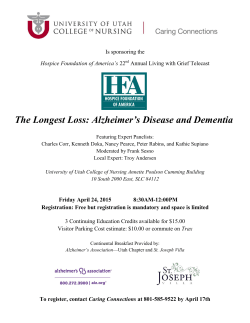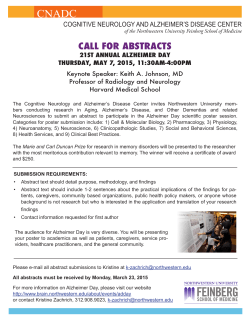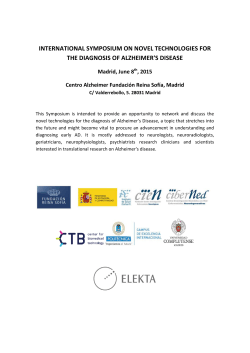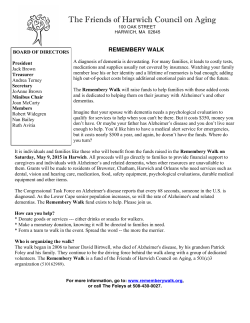
Neurodegenerative Disease Research in the College of Science
Neurodegenerative Disease Research in the College of Science Researchers at the University of Notre Dame are making groundbreaking research discoveries in the field of neurodegenerative diseases. Understanding all aspects of the nervous system, including development, function, and regeneration, is one of the biggest challenges of the modern scientific era. The goal of the interdisciplinary research at Notre Dame into the structure and function of the brain and nervous system is to discover the molecular and cellular basis of neurological disorders, and identify pharmaceutical and behavioral treatments for issues pertaining to the nervous system. There are more than 600 neurological diseases. The majority are rare diseases, such as NPC. Neurodegenerative research projects David Hyde studies the mechanisms underlying retinal development and regeneration in zebrafish. Unlike that of most vertebrates, the zebrafish retina and central nervous system (including the brain) possess a robust regeneration response. By studying the mechanism of zebrafish retinal regeneration, he hopes find a way to induce a human retinal regeneration response, which holds the promise of repairing the damage in a variety of human retinal diseases, such as macular degeneration, retinitis pigmentosa, glaucoma, and diabetic retinopathy. It is also possible that a regeneration response may be induced to restore neurons to repair spinal cord injuries or to repair specific brain areas that are affected in a variety of diseases. The Hyde lab is already investigating this application for Parkinson’s disease. More than 1.6 million Americans age 50 and older have late age-related macular degeneration. Lei Li searches for gene mutations that cause photoreceptor cell degeneration, resulting in abnormal visual behaviors like night blindness. His studies aim to better understand the mechanisms that underlie age-related visual problems. Joseph O’Tousa examines the biochemical mechanisms and genetic causes underlying degeneration of photoreceptors in the eye, the sensory cells responsible for light reception. By understanding the basic operations of cellular signaling in the eyes, treatments can be developed to treat retinal degeneration and other visual system orders. More than 5 million Americans are living with Alzheimer’s disease. Rich Taylor researches a series of compounds called epothilones and their analogs which are known to stabilize cell microtubules, structures that transport nutrients across the cell. In Alzheimer’s patients, disruption of protein functions can cause microtubules to break down, resulting in nerve damage. Epothilones may help stabilize the microtubules in the cells of Alzheimer’s patients and could lead to a potential treatment for early stages of the disease. Niemann-Pick Type C is a rare and deadly neurodegenerative disease that primarily strikes children before or during adolescence. The National Institutes of Health refers to NPC as “childhood Alzheimer’s” because of similarities in the brains of NPC and Alzheimer’s disease patients. In NPC patients, cellular cholesterol accumulates in the body, eventually leading to loss of neurons in the brain. Paul Helquist and Olaf Wiest have screened several histone deacetylase (HDAC) inhibitors that help effectively transport cholesterol in the cells and have found very favorable effects on the NPC disease model. Kasturi Haldar, Kevin Vaughn, Holly Goodson, Malcolm Fraser, Matt Champion, and Crislyn D’Souza Schorey are also involved in NPC research. Norman Dovichi played an important role in the Human Genome Project, the most ambitious project in analytical chemistry to date. Now that the genome is sequenced, scientists have turned their efforts to sequencing the proteome in order to understand how all the components of the cell function, which is necessary to understand health and disease. Dovichi is currently working to characterize the metabolism of sphingolipids, the glycolipids that make up a large portion of the neuronal membrane. Defects in the metabolism of these glycolipids lead to devastating genetic diseases, such as Niemann-Pick disease, Fabry disease, and Gaucher’s disease. Mayland Chang and Shahriar Mobashery of the Department of Chemistry and Biochemistry have created an injectable compound called SB-3CT. When used in combination with t-PA, an FDA-approved treatment to dissolve blood clots, SB-3CT would reduce the injury of damaged brain cells and extend the time window for treatment. Further, this compound has shown to be effective in repairing damaged brain cells due to traumatic brain injuries. Stroke is the third leading cause of death and the primary cause of long-term disability in the United States. Giles Duffield focuses on understanding the molecular basis for the circadian clock in both vertebrate and invertebrate animals. Dysfunction of the circadian clock underlies several disease states including Seasonal Affective Disorder and sleep and metabolic disorders associated with shift-work, including obesity and diabetes. One-third to one-half of Alzheimer’s patients have obstructive sleep apnea, and three-quarters to almost all of the people with Parkinson’s have sleep disturbances. science.nd.edu
© Copyright 2025









